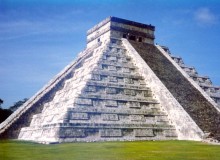Article/Document:
Von Daniken's Chariots of the Gods - Documentary film review
Adam K. Nelson
original source | fair use notice
Summary: In Chariots of the Gods, von Daniken collected and documented evidence from around the world that supports the idea that the bulk of human achievement across the millennia can be attributed to the influence of alien civilizations, merely passing through.
Based on Erich von Daniken's monumental bestseller, this documentary takes the profound and makes it plausible.
Photography: Ernst Wild
Editor: Herman Haller
Commentary: Wilhelm Roggersdorf
Narration: Bruce Johansen, Lee Pajan and Jean Fontaine
Executive Producer: Dr. Manfred Barthel
Director: Dr. Harold Reinl
Based on Chariots of the Gods and Return to the Stars by Erich von Daniken
During World War II, American soldiers occupied islands throughout the Pacific, looking for combat situation vantage points. Their plan was to find a place from which to launch a strategic attack or at the very least gain firsthand intelligence of the enemy’s plans. What they did not plan was for the indigenous peoples of these islands to regard them as gods and attempt to adopt their tools and technology. Twenty years later, still in the stone age, the same indigenous peoples built runways lined with coconuts and airplanes composed of foliage. They searched the skies nightly for signs of the returning visitors, hoping the gods would come back and teach them even more. Remarkably, due to our encroachment on their world, these Pacific Islanders developed a new religion.
This scenario opens the monumental documentary, Chariots of the Gods, the international marvel based on Erich von Daniken’s book of the same name. Directed by Dr. Harold Reinl, the film does not feature von Daniken as a narrator or a guest, but his rhetoric runs rampant. Von Daniken noticed something that seemed to be escaping even the most educated of sociologists, archaeologists and religious scholars: the possibility that behind every culture’s mythology exists a similar underlying fact. If the religion practiced by the Pacific Islanders began as a result of a visiting culture from Somewhere Else, may one presume that other religions around the world started in the same manner? Von Daniken believes this may very well be the case. The mysterious figures represented in ancient sculptures, cave paintings, engravings and texts may not be gods at all, but extraterrestrial visitors who left their imprint on global cultures much as American soldiers did for the Pacific Islanders during World War II.
Von Daniken’s hypothesis may seem outrageous, to be sure, but what is even more outrageous is the idea that the profound achievements that took place in ancient cultures were merely the natural process of unassisted human development. Are we to believe, for instance, that thousands of years ago, before the advent of modern machinery, Egyptian workers transferred the massive blocks used to build the Great Pyramids across northern Africa using wooden rollers, a process that would have taken over 600 years, according to mathematic estimation? While we know from archaeological evaluation that building the pyramids certainly took a while, the process was much, much less than 600 years. So how did they do it? According to von Daniken, the Egyptians may have performed this gargantuan feat in much the same way that the ancient people of Easter Island transported the stone used to carve the famous, haunting face sculptures that stand along the island’s edge: they had help. He extends this idea to practically every major cultural, religious and societal belief system, including biblical cultures.
In Chariots of the Gods, von Daniken collected and documented evidence from around the world that supports the idea that the bulk of human achievement across the millennia can be attributed to the influence of alien civilizations, merely passing through. This idea transfers expertly to film, thanks to Ernst Wild’s non-stop on-location photography and competent editing by Herman Haller. The film’s subject matter may send the viewer’s mind reeling, but it never loses it. The photography follows the narration line-for-line. When Bruce Johansen, Lee Pajan, or Jean Fontaine discuss a cave painting that depicts visitors blazing across the sky in space vehicles, the film shows us immediately so we do not have to take their word for it. The camera is always moving, always capturing. Many documentary filmmakers mistakenly express their views by focusing on experts seated in front of the camera. These experts use terminology that eludes the common viewer. Chariots of the Gods allows the evidence itself to be the expert, serving it up for our judgment instead of forcing us to swallow that of others.
It is perhaps for this very reason that Chariots of the Gods, in spite of its controversial statements about the development of human intelligence, became an international sensation. Von Daniken has the gift of a child’s wonderment coupled with an adult’s ability to rationalize. As a result of this combination, Chariots of the Gods is a lot of fun, both as a book and in film. Rarely has the study of origin been so entertaining. Before attending von Daniken’s convocation on November 1, you may want to view Chariots of the Gods. If the film is any indication of what to expect, some very intense jaw-dropping may be in Drury’s future.
Read more articles on this topic:






